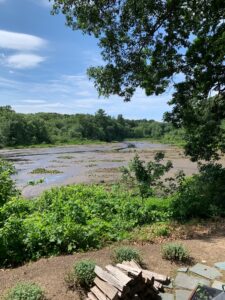Rivers are naturally dynamic, constantly changing environments and river creatures can tolerate a wide range of flow conditions. However, extreme low-flow and no-flow conditions can cause considerable harm. Severe, frequent low-flow events stress fish and aquatic communities in the PIE-Rivers, especially in the Parker and Ipswich Rivers. While a number of issues contribute to the frequency and severity of low-flow events, groundwater withdrawals for municipal and private use is a major driving factor. The most severe impacts are from summer groundwater withdrawals, which capture water that the rivers need to maintain flow. Withdrawals from reservoirs can also be damaging under some circumstances. The withdrawal impacts are exacerbated by large water transfers out of the watershed or sub-basin, either for use in surrounding communities or as wastewater. This represents a substantial net loss of water to the river system and the estuary.

Water is also lost through groundwater seeping directly into sewer systems and flowing out of the basin without ever being used. Additionally, factors such as increased impervious surfaces and the development of groundwater recharge areas (see Upland Development) further exacerbate the problem.
Water demand peaks during hot summer months as large numbers of people water lawns and fill swimming pools. This situation, combined with a period of naturally low flow, cause the rivers to fall below safe levels. The upper Ipswich River would be pumped dry on a nearly annual basis prior to the Town of Reading’s 2006 decision to discontinue using its municipal wells near the river. This decision, along with a number of water-saving measures employed by Reading and other towns, has improved conditions on the Ipswich River; but flow levels still regularly drop below ecological thresholds identified by the USGS (Armstrong et al., 2001) and further improvements are needed. Tributaries such as Martins Brook, Lubbers Brook, Norris Brook, Emerson Brook, Idlewild Brook and Mile Brook continue to be pumped dry or heavily impacted. The upper Parker River is also significantly affected, and the Mill and Egypt-Rowley River sub-basins are severely impacted by water withdrawals (Gomez and Sullivan, 2003; EOEA, 2005).
Consequences of Low Flow
Low flows reduce available river habitat by shrinking the overall water volume in the channel and dewatering important areas including riffles and channel margins (nearest the riverbanks). Channel habitat can become physically disconnected from critical spawning, rearing, and feeding habitats in side channels and wetlands that border on the river. In extreme cases, the channel itself can stop flowing and be reduced to a series of isolated pools.
The smaller, slower moving volume of water in the river also influences water temperature and water quality. Reduced volume leads to higher stream temperatures in the summer.. High water temperature can kill organisms directly, and also decreases the amount of oxygen water will hold while simultaneously increasing the amount of oxygen fish and other organisms require for survival, resulting in lower dissolved oxygen. Temperature and dissolved oxygen conditions can further interact to degrade water quality by affecting how toxins and other chemicals behave.
As waters reach the estuary, lower river flow changes salinity, reduces sediment transport, and alters nutrient processes in the salt marshes. Saline water can encroach farther upstream, eliminating key spawning habitat and affecting water chemistry. These alterations can have a lasting impact on plant and animal communities that utilize the estuarine environment.
